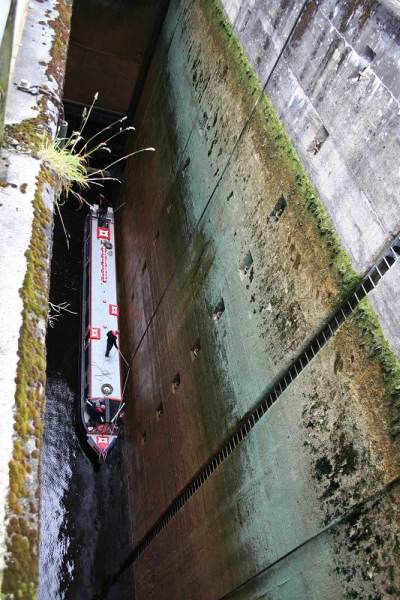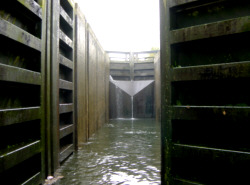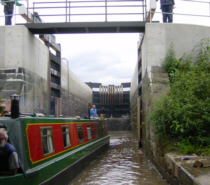Which are the deepest canal locks in England and Wales?
For comparison, this page lists those non-tidal canal and river locks that have a rise (or fall) of over 11 feet.
The rise (or fall) is measured as the difference in level between the normal water level above the lock and the normal water level below the lock.
| Lock name | Number | Canal | Rise (change in level) | Other information | |
| Tuel Lane Lock | 3/4 | Rochdale | 19' 8½" | 6.00m | manned; new lock replacing two locks |
| Bath Deep Lock | 8/9 | Kennet and Avon | 19' 5" | 5.92m | new lock replacing two locks |
| Middlewood Deep Lock | 1/2 | Manchester Bolton & Bury | 16' 3" approx | 5m approx | manned; new lock replacing two locks; rise varies with level of River Irwell |
| Anthony Lock | 77 | Rochdale | 15' 1½" | 4.61m | deepened due to mining subsidence |
| Aberfan Locks | 6, 7 | Glamorganshire | 14' 6" | 4.42m | 2-lock staircase, total rise 29', average 14' 6" each. Deepest canal locks in Britain when in operation. Closed in 1898 due to mining subsidence. Only a section of chamber wall remaining. |
| Vinegar Lock | 10 | Ashton | 13' 10" | 4.22m | part of the Clayton flight - now the deepest narrow lock in Britain |
| Lemonroyd Lock | Aire and Calder | 13' 6" | 4.11m | new lock replacing two locks | |
| Woodnook Lock | Aire and Calder | 13' 6" | 4.11m | new lock replacing Altofts and Fairies Hill Locks | |
| Harry Garner's Lock | 6 | Ashton | 13' 3" | 4.05m | part of the Beswick flight |
| Etruria Top Lock | 40 | Trent and Mersey | 13' 2" | 4.01m | at southern end of T&M summit |
| Marple Locks | 1-16 | Peak Forest | 13' 1" | 3.99m | 16 locks, total rise of 209 ft 6in, average around 13' 1" each Click here to see details of the individual locks at Marple |
| Nan Fox's Lock | 5 | Ashton | 12' 9½" | 3.90m | part of the Beswick flight |
| Clayton Lock | 8 | Ashton | 12' 9" | 3.89m | part of the Clayton flight |
| Stourport Broad Locks | Staffordshire and Worcestershire | 12' 4" | 3.76m | linking Stourport Basin with River Severn, two broad locks, total rise 24' 8", average 12' 4" each | |
| Stenson Lock | 6 | Trent and Mersey | 12' 2" | 3.71m | |
| Somerton Deep Lock | 34 | Southern Oxford | 12' 0" | 3.66m | |
| Holme Lock | River Trent | 12' 0" | 3.66m | manned | |
| Blowers Green Lock | Stourbridge | 12' 0" | 3.66m | deepest lock on BCN, replaced two locks | |
| York Street Lock | Staffordshire and Worcestershire | 12' 0" | 3.66m | linking canal with Stourport Basin | |
| Appley Lock | 91 | Leeds and Liverpool | 12' 0" | 3.66m | parallel to two shallower (now disused) locks |
| Bingley Five Rise | 25-29 | Leeds and Liverpool | 12' 0" each | 3.66m | 5 locks in a staircase, total rise 60', therefore 12' 0" rise for each lock |
| Tinsley Deep Lock | 7/8 | Sheffield and Tinsley Canal | 12' 0" | 3.66m | deep lock built to replace Locks 7 & 8 in 1959 to allow construction of rail bridge |
| Stoke Bottom Lock | 36 | Trent and Mersey | 11' 11" | 3.63m | |
| Bratch Bottom Lock | Staffordshire and Worcestershire | 11' 10½" | 3.61m | The three locks at The Bratch have widely different rises (middle lock 2.57m, top lock 3.30m). | |
| Kidderminster Lock | Staffordshire and Worcestershire | 11' 10" | 3.60m | ||
| Slaters Higher Lock | 75 | Rochdale | 11' 10" | 3.60m | |
| Tardebigge Top Lock | 58 | Worcester and Birmingham | 11' 7" | 3.53m | replaced an earlier vertical lift - sometimes incorrectly claimed to be 14ft |
| Fourteen Locks | Crumlin Arm, Monmouthshire Canal | 11' 5" | 3.48m | disused, partly restored, 14 locks in just 800m yards, total rise 160', average 11' 5" each lock | |
| Cholmondeston Lock | 1 | Middlewich Branch, Shropshire Union | 11' 3" | 3.43m | |
| Engine Lock | 4 | Caldon | 11' 3" | 3.42m | |
| Hanbury Top Lock | 1 | Droitwich Junction Canal | 11' 2" | 3.40m | re-opened in 2011 after restoration |
| Slaters Lower Lock | 76 | Rochdale | 11' 2" | 3.40m | |
| Hunts Lock | 2 | River Weaver | 11' 2" | 3.40m | |
| Denham Deep Lock | 87 | Grand Union Canal South | 11' 1" | 3.38m | |
| Stanthorne Lock | 3 | Middlewich Branch, Shropshire Union | 11' 1" | 3.38m | |
| Northgate Locks | 41-43 | Shropshire Union | 11' 0" | 3.35m | Three-rise staircase, total rise 33', average 11' 0" although the middle lock is deeper than the others. Originally built as a 5-rise staircase down towards the river, the bottom two locks were re-located to what is now the Dee Branch when the line through to Ellesmere Port was constructed. |
| Minshull Lock | 2 | Middlewich Branch, Shropshire Union | 11' 0" | 3.35m | |
| Coalpit Higher Lock | 78 | Rochdale | 11' 0" | 3.35m | |

Upper chamber at Ardnacrusha, Republic of Ireland. Photo: BJ Goggin
I have measured some of these locks myself. Some have been measured by other people for me or for other purposes. Some are taken from historical data elsewhere. My particular thanks to Andrew and Paul Balmer of Waterway Routes for sharing their measurements of a number of these locks.
"Deep Lock" (no. 47) on the Chesterfield Canal near Worksop has a rise of 10 feet (3 metres), so is only deep in comparison with other locks on that canal.
On the Manchester Ship Canal, not part of the network available to the casual canal boater, Latchford, Irlam, Barton and Mode Wheel locks each have a rise of 14' 6" (4.41m). Eastham Lock is tidal so has a variable rise.
This page lists deep locks in England and Wales, but it is worth mentioning Ardnacrusha in the Republic of Ireland.
A dam was constructed across the River Shannon at Ardnacrusha, near Limerick, as part of a hydro-electric generation scheme in 1929. The river navigation bypasses the dam in a canal channel that has a double lock (two-rise lock staircase) with a total rise of 102 feet (31m)!
The two chambers have rises of around 68 ft and 34 ft respectively. Passage through the double lock can take between 45 and 60 minutes. (See photo on right.)
The deepest lock in the world is Oskemen Lock, bypassing a hydro-electric dam on the River Ertis in Kazakhstan, with an incredible rise of 138 ft (42m).


